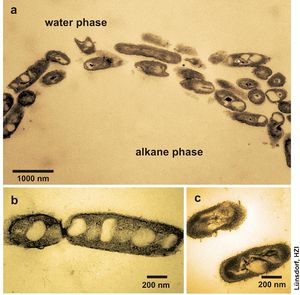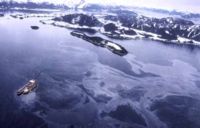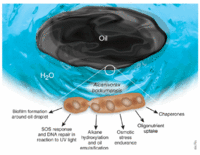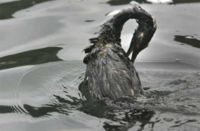Microvirgula aerodenitrificans: Difference between revisions
No edit summary |
|||
| Line 1: | Line 1: | ||
{{Curated}} | {{Curated}} | ||
[[Image:AlcVorax PROCARYOTES01b-1.JPG|thumbnail|300px|Figure 1. ''Alcanivorax borkumensis''. Image from Helmholtz Centre for Infection Research[http://www.helmholtz-hzi.de/en/news_public_relation/press_releases/view/article/complete/oil_tanker_accidents_as_a_source_of_food/]]] | |||
[[Image: | |||
==Classification== | ==Classification== | ||
'''Bacteria'''; Phylum: '''Proteobacteria'''; Class: '''Gammaproteobacteria'''; Order: '''Oceanospirillales'''; Family: '''Alcanivoracaceae''' | |||
===Species=== | |||
{| | |||
| height="10" bgcolor="#FFDF95" | | |||
'''NCBI: [http://www.ncbi.nlm.nih.gov/Taxonomy/Browser/wwwtax.cgi?mode=Tree&id=2&lvl=3&lin=f&keep=1&srchmode=1&unlock Taxonomy]''' | |||
|} | |||
*''Alcanivorax balearicum'' | |||
*''Alcanivorax borkumensis'' | |||
*''Alcanivorax dieselolei'' | |||
*''Alcanivorax indicus'' | |||
*''Alcanivorax jadensis'' | |||
*''Alcanivorax venustensis'' | |||
==Description and Significance== | ==Description and Significance== | ||
[[Image:PWS tanker oil spill.jpg|thumbnail|200px|Figure 2. Supertanker Exxon Valdez grounded on Bligh Reef which released 11 million gallons of crude oil into the water. This oil-contaminated seawater is the preferred habitat for ''Alcanivorax''. Image from USGS[http://menlocampus.wr.usgs.gov/50years/accomplishments/oil.html]]] | |||
''Alcanivorax'', first described in 1998, is a Gram-negative, halophilic, aerobic, rod-shaped, oil-degrading marine bacterium that is found in low abundances in unpolluted environments in the upper layers of the ocean, but quickly becomes the predominant microbe in oil-contaminated open oceans and coastal waters when nitrogen and phosphorus are not limiting [2]. When conditions in these moderately halophilic environments are right, ''Alcanivorax'' may make up 80-90% of the oil-degrading microbes present in the area [4]. It is described as a non-motile bactertium which is true for species such as ''Alcanivorax borkumensis'', but other species such as ''Alcanivorax venustensis'' were described to be motile by polar flagella [1]. The optimial conditions described for A.borkumensis growth include temperatures in the range of 20-30 degrees celsius, and a NaCl concentration of 3-10%. | |||
As a result of their profound ability to degrade and live predominately on alkanes, as well as to become the dominant microbes in oil-contaminated areas, ''Alcanivorax'' plays a huge role in the biological cleanup of oil-contaminated environments. These oil-contaminated environments in the ocean are largely due to anthropogenic sources such as oil spills caused by tankers accidents (Figure 2), and cause serious ecological damage to plants and animals on the coast as well as other inhabitants of the ocean. Microbes such as ''Alcanivorax'' provide a major route for the breakdown of these pollutants, and demonstrate how marine bacteria keep the environment in check. Of all the ''Alcanivorax'' species and other oil-degrading microbes, ''Alcanivorax borkumensis'' is one of the most important worldwide due to the fact it produces a wide variety of very efficient oil-degrading enzymes. With this knowledge, ''A. borkumensis'' could provide a useful tool for bioremediation of oil spills. | |||
==Genome Structure== | |||
[[Image:Lorenzo.gif|thumbnail|200px|Figure 3. Mechanisms for oil degradation and survival encoded by the ''A. borkumensis SK2'' genome. Image from Victor de Lorenzo[http://www.nature.com/nbt/journal/v24/n8/full/nbt0806-952.html]]] | |||
The | The ''Alcanivorax borkumensis'' strain SK2, isolated from a seawater sediment sample in the North Sea at a site located near the Isle of Borkum, was the first hydrocarbonoclastic bacterium to be sequenced and was completed by Susanne Schneiker et al. It's genome consists of a single circular chromosome with 3,120,143 base pairs and an average G+C content of 54.7%. The genomic analysis of ''A. borkumensis SK2'' revealed several new insights into the bacterium's role for (i) n-alkane degradation (which includes metabolism, biosurfactant production and biofilm production), (ii) it's system for capturing or scavenging the small amounts of nitrogen, phosphorous, sulfur, and other elements in a nutrient-poor marine environment which allows for more efficient alkane degradation due to their main limitation of nutrient availability, (iii) as well as means for coping with stress factors such as high salt contents and high UV radiation since it thrives mostly in the upper layers in the ocean where UV light is encountered (Figure 3). | ||
It's genome encodes several systems for the catabolism of hydrocarbons which allow the bacertium to degrade all sorts of alkanes such as AlkB1 alkane hydroxylase which oxidizes medium-chain alkanes in the range of C5-C12, and AlkB2 alkane hydroxylase which oxidizes medium-chain alkanes in the range of C8 to C16. Both these systems are located close to the origin of replication of the chromosome. ''A. borkumensis'' is also able to degrade alkanes up to C32, branched aliphatic hydrocarbons, isoprenoid hydrocarbons such as phytane, as well as alkylarenes and alkylcycloalkanes. Thus, the genome encodes for a broad spectrum of systems for the catabolism of hydrocarbons, giving it a competitive advantage over other oil-degrading marine microbial communities. To deal with the damaging effects of UV light, ''A. borkumensis'' has a number of genes that reduce the damage. These include the full genes for DNA alkylation, recombinational and nucleotide excision repair, base excision repair, as well as the SOS response [4]. | |||
==Cell Structure, Metabolism and Life Cycle== | |||
''Alcanivorax borkumensis'', a Gram-negative, rod-shaped chemoorganotroph, is able to use n-alkanes as its principle carbon and energy source by use of the broad spectrum of oil-degrading enzymes it possesses, but they can also use a limited number of organic compounds such as aliphatic hydrocarbons, volatile fatty acids, and pyruvate. However, it cannot utilize carbon sources such as sugars or amino acids. Cells grown with pyruvate were observed to be 2.0-3.0 micrometers in length and 0.4-07 micrometers in diameter, however, cells were shorter (1.0-1.5 micrometers in length) when cells were grown with n-alkanes as the carbon source (see Figure 1) [5]. When the slow growing ''A. borkumensis'' uses n-alkanes exclusively, the microbes produce extracellular and membrane-bound surface-active glucose lipids called biosurfactants. These biosurfactants reduce the surface tension of water from 72 to 29 mN m-1 and act as natural emulsifiers which enhances the break up of oil-in-water emulsions [4,5]. Due to the low solubility of oil in water, most oil degradation takes place at the oil-water interface where ''A. borkumensis'' attaches and forms a biofilm around the oil droplets as depicted in Figure 3. | |||
==Ecology== | ==Ecology== | ||
[[Image:OilContamination.jpg|thumbnail|200px|Figure 4. Oil spills in the ocean affect more than the aquatic environment. ''Alcanivorax'' helps reduce the damage on ecosystem health.]] | |||
''Alcanivorix'' is a novel species living in the oceans that plays a major role in keeping our pristine oceans as well as the inhabitants of the ocean and the inhabitants of the coastal regions in good health. It has been detected worldwide in places such as the Mediterranean Sea, Pacific Ocean, and the Arctic Sea [4]. In seawater with high concentrations of n-alkanes (as a result of oil spills, natural oil fields, and/or processing plants), ''Alcanivorax'' quickly becomes the predominant microbial community and is found in higher populations when compared to ''Alcanivorax'' in unpolluted seawater. There have been several recent fields studies on bacterial community dynamics and hydrocarbon degradation in coastal areas contaminated with oil. These field studies have demonstrated the immense importance of ''Alcanivorax'' (particularly ''A. Borkumensis'') in oil-spill bioremediation [2]. | |||
==References== | ==References== | ||
[ | [1] [http://ijs.sgmjournals.org/cgi/content/abstract/53/1/331 Fernandez-Martinez, Javier, Maria J. Pujalte, Jesus Garcia-Martinez, Manuel Mata, Esperanza Garay, and Francisco Rodriguez-Valera. "Description of ''Alcanivorax Venustensis'' sp. nov. and Reclassification of ''Fundibacter Jadensis'' DSM 12178T (Bruns and Berthe-Corti 1999) As ''Alcanivorax Jadensis'' comb. nov., Members of the Emended Genus ''Alcanivorax''." International Journal of Systematic and Evolutionary Microbiology 53 (2003): 331-338.] | ||
[http:// | |||
[http://www. | [2] [http://www.blackwell-synergy.com/doi/pdf/10.1046/j.1468-2920.2003.00468.x Hara, Akihiro, Kazuaki Syutsubo, and Shigeaki Harayama. "''Alcanivorax'' Which Prevails In Oil-contaminated Seawater Exhibits Broad Substrate Specificity For Alkane Degradation." Environmental Microbiology 5.9 (2003): 746-753.] | ||
[http://www. | [3] [http://www.nature.com/nbt/journal/v24/n8/full/nbt0806-952.html Lorenzo, Víctor De. "Blueprint of an Oil-eating Bacterium." Nature Biotechnology 24 (2006): 952-953.] | ||
[http://www. | [4] [http://www.ncbi.nlm.nih.gov/pubmed/16878126 Schneiker, S. et al. "Genome Sequence of the Ubiquitous Hydrocarbon-degrading Marine Bacterium A''lcanivorax Borkumensis''." Nature Biotechnology 24 (2006): 997-1004.] | ||
[http:// | [5] [http://ijs.sgmjournals.org/cgi/content/abstract/48/2/339 Yakimov, Michail M., Peter N. Golyshin, Siegmund Lang, Edward R. B. Moore, Wolf-Rainer Abraham, Heinrich Lunsdorf, and Kenneth N. Timmis. "''Alcanivorax Borkumensis'' gen. nov., sp. nov., A New, Hydrocarbon-degrading And Surfactant-producing Marine Bacterium." International Journal of Systematic Bacteriology 48 (1998): 339-348.] | ||
[http://www. | ==Author== | ||
Page authored by Andrew Buss, student of [http://www.kbs.msu.edu/faculty/lennon/ Prof. Jay Lennon] at Michigan State University. | |||
<!--Do not edit or remove this line-->[[Category:Pages edited by students of Jay Lennon at Michigan State University]] | |||
Revision as of 02:00, 14 December 2012

Classification
Bacteria; Phylum: Proteobacteria; Class: Gammaproteobacteria; Order: Oceanospirillales; Family: Alcanivoracaceae
Species
|
NCBI: Taxonomy |
- Alcanivorax balearicum
- Alcanivorax borkumensis
- Alcanivorax dieselolei
- Alcanivorax indicus
- Alcanivorax jadensis
- Alcanivorax venustensis
Description and Significance

Alcanivorax, first described in 1998, is a Gram-negative, halophilic, aerobic, rod-shaped, oil-degrading marine bacterium that is found in low abundances in unpolluted environments in the upper layers of the ocean, but quickly becomes the predominant microbe in oil-contaminated open oceans and coastal waters when nitrogen and phosphorus are not limiting [2]. When conditions in these moderately halophilic environments are right, Alcanivorax may make up 80-90% of the oil-degrading microbes present in the area [4]. It is described as a non-motile bactertium which is true for species such as Alcanivorax borkumensis, but other species such as Alcanivorax venustensis were described to be motile by polar flagella [1]. The optimial conditions described for A.borkumensis growth include temperatures in the range of 20-30 degrees celsius, and a NaCl concentration of 3-10%.
As a result of their profound ability to degrade and live predominately on alkanes, as well as to become the dominant microbes in oil-contaminated areas, Alcanivorax plays a huge role in the biological cleanup of oil-contaminated environments. These oil-contaminated environments in the ocean are largely due to anthropogenic sources such as oil spills caused by tankers accidents (Figure 2), and cause serious ecological damage to plants and animals on the coast as well as other inhabitants of the ocean. Microbes such as Alcanivorax provide a major route for the breakdown of these pollutants, and demonstrate how marine bacteria keep the environment in check. Of all the Alcanivorax species and other oil-degrading microbes, Alcanivorax borkumensis is one of the most important worldwide due to the fact it produces a wide variety of very efficient oil-degrading enzymes. With this knowledge, A. borkumensis could provide a useful tool for bioremediation of oil spills.
Genome Structure

The Alcanivorax borkumensis strain SK2, isolated from a seawater sediment sample in the North Sea at a site located near the Isle of Borkum, was the first hydrocarbonoclastic bacterium to be sequenced and was completed by Susanne Schneiker et al. It's genome consists of a single circular chromosome with 3,120,143 base pairs and an average G+C content of 54.7%. The genomic analysis of A. borkumensis SK2 revealed several new insights into the bacterium's role for (i) n-alkane degradation (which includes metabolism, biosurfactant production and biofilm production), (ii) it's system for capturing or scavenging the small amounts of nitrogen, phosphorous, sulfur, and other elements in a nutrient-poor marine environment which allows for more efficient alkane degradation due to their main limitation of nutrient availability, (iii) as well as means for coping with stress factors such as high salt contents and high UV radiation since it thrives mostly in the upper layers in the ocean where UV light is encountered (Figure 3).
It's genome encodes several systems for the catabolism of hydrocarbons which allow the bacertium to degrade all sorts of alkanes such as AlkB1 alkane hydroxylase which oxidizes medium-chain alkanes in the range of C5-C12, and AlkB2 alkane hydroxylase which oxidizes medium-chain alkanes in the range of C8 to C16. Both these systems are located close to the origin of replication of the chromosome. A. borkumensis is also able to degrade alkanes up to C32, branched aliphatic hydrocarbons, isoprenoid hydrocarbons such as phytane, as well as alkylarenes and alkylcycloalkanes. Thus, the genome encodes for a broad spectrum of systems for the catabolism of hydrocarbons, giving it a competitive advantage over other oil-degrading marine microbial communities. To deal with the damaging effects of UV light, A. borkumensis has a number of genes that reduce the damage. These include the full genes for DNA alkylation, recombinational and nucleotide excision repair, base excision repair, as well as the SOS response [4].
Cell Structure, Metabolism and Life Cycle
Alcanivorax borkumensis, a Gram-negative, rod-shaped chemoorganotroph, is able to use n-alkanes as its principle carbon and energy source by use of the broad spectrum of oil-degrading enzymes it possesses, but they can also use a limited number of organic compounds such as aliphatic hydrocarbons, volatile fatty acids, and pyruvate. However, it cannot utilize carbon sources such as sugars or amino acids. Cells grown with pyruvate were observed to be 2.0-3.0 micrometers in length and 0.4-07 micrometers in diameter, however, cells were shorter (1.0-1.5 micrometers in length) when cells were grown with n-alkanes as the carbon source (see Figure 1) [5]. When the slow growing A. borkumensis uses n-alkanes exclusively, the microbes produce extracellular and membrane-bound surface-active glucose lipids called biosurfactants. These biosurfactants reduce the surface tension of water from 72 to 29 mN m-1 and act as natural emulsifiers which enhances the break up of oil-in-water emulsions [4,5]. Due to the low solubility of oil in water, most oil degradation takes place at the oil-water interface where A. borkumensis attaches and forms a biofilm around the oil droplets as depicted in Figure 3.
Ecology
Alcanivorix is a novel species living in the oceans that plays a major role in keeping our pristine oceans as well as the inhabitants of the ocean and the inhabitants of the coastal regions in good health. It has been detected worldwide in places such as the Mediterranean Sea, Pacific Ocean, and the Arctic Sea [4]. In seawater with high concentrations of n-alkanes (as a result of oil spills, natural oil fields, and/or processing plants), Alcanivorax quickly becomes the predominant microbial community and is found in higher populations when compared to Alcanivorax in unpolluted seawater. There have been several recent fields studies on bacterial community dynamics and hydrocarbon degradation in coastal areas contaminated with oil. These field studies have demonstrated the immense importance of Alcanivorax (particularly A. Borkumensis) in oil-spill bioremediation [2].
References
[3] Lorenzo, Víctor De. "Blueprint of an Oil-eating Bacterium." Nature Biotechnology 24 (2006): 952-953.
Author
Page authored by Andrew Buss, student of Prof. Jay Lennon at Michigan State University.

